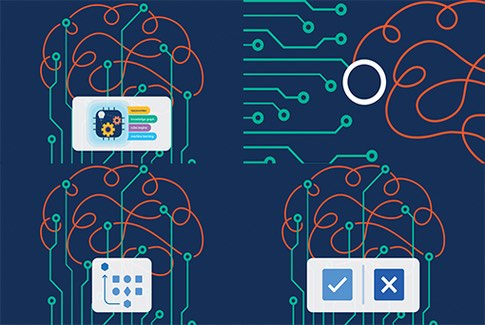
Text mining has become an essential capability of the modern enterprise. With unstructured data growing exponentially, companies are leveraging text mining to make these large quantities of unstructured data accessible and useful. In doing so, they have been able to generate deeper business insight and make smarter business decisions for a number of use cases.
Text mining uses techniques such as text classification, entity extraction (i.e., named entity recognition) and sentiment analysis to extract useful information and knowledge hidden in text content. In the business world, this enables companies to reveal insights, patterns and trends from large volumes of unstructured data. In fact, this ability to push aside all non-relevant material and provide valuable answers has led to its rapid adoption throughout the enterprise.
The following 10 text mining examples demonstrate how practical application of unstructured data management techniques can impact not only your organizational processes, but also your competitive standing.
Risk Management
No matter the industry, insufficient risk analysis is often a leading cause of failure. This is especially true in the financial and insurance industries where adoption of risk management software based on text mining technology can dramatically increase the ability to mitigate risk. This provides organizations with easy access to thousands of sources (and petabytes) of text documents, enabling them to link together information and access the right information at the right time.
Knowledge Management
When managing large volumes of text documents, your ability to find important information quickly is essential. Look no further than the healthcare industry where organizations have tremendous amounts of information (e.g., decades of research, clinical patient data, etc.) that could be of value to their largest profit center: new product development. Text mining solutions can help organizations locate information quickly and accurately, enabling them to unlock deeper insights and deliver products to the market faster.
Cybercrime Prevention
The anonymous nature of the internet and the many communication features operated through it contribute to the increased risk of internet-based crimes. Today, text mining is making cybercrime prevention easier for enterprise organizations as well as law enforcement by establishing more context around the intelligence they are being fed. This enables them to pinpoint real threats and limit the number of false positives created by keywords taken out of context.
Enhanced Customer Service
Text mining and natural language processing have proven immensely helpful for customer care teams. They are commonly adopted to improve the customer experience by leveraging valuable information sources such as surveys, trouble tickets and customer call notes to improve the quality, effectiveness and speed of problem resolution. Text analysis is also central to chatbots as it captures the information necessary to provide a rapid, automated response to the customer. As a result, companies can dramatically reduce their reliance on call center operators to solve customer problems.
Streamlined Claims Investigation
Text analytics is a tremendously effective technology in any domain where the majority of information is collected as text. For instance, the insurance industry has several unique text analysis use cases. Some of the most common use cases include policy review, claims automation and risk engineering. Text mining enables insurance companies to quickly locate specific information that could take a human hours to do manually. Not only does it make time-consuming processes more efficient, but it helps reduce risk exposure across portfolios.
Contextual Advertising
Digital advertising is a moderately new and growing field of application for text analytics. Compared to the traditional cookie-based approach, contextual advertising analyzes the text on a webpage to understand the content on a deeper level. For example, someone reading an article about the top new book releases may be served an ad for Kindle due to its relevance. This is not only beneficial in terms of serving more accurate and targeted advertisements, but it completely preserves user privacy.
Business Intelligence
Business intelligence tools have become fixtures in most enterprise decision-making processes. By collecting, storing and analyzing data for you, these tools enable you to identify patterns, trends and opportunities from your data far quicker than you could manually. By bringing text mining into the equation, BI tools are able to leverage your unstructured data in addition to your structured data and expand the data sets with which your model uses to generate business insight. This enables you to create more robust BI models that deliver more relevant business insight.
Content Enrichment
While it is true that working with text-based content requires a bit of human effort, text mining can make a significant difference when it comes to more effectively managing large volumes of information. For instance, text mining can enrich content and improve metadata management processes by providing a scalable layer to tag, organize and summarize your available content. This makes it far easier to discover specific content and use it for a variety of purposes.
Spam Filtering
Email is an effective, fast and reasonably cheap way to communicate, but it comes with a dark side: spam. Today, spam is a major issue for internet service providers, increasing their costs for service management and hardware software updating. For users, spam is both an entry point for viruses and a detriment to productivity. Text mining techniques can be implemented to improve the effectiveness of statistical filtering methods by leveraging established prior knowledge. This not only makes for more efficient email management, but it improves the user experience considerably.
Social Media Data Analysis
Today, social media is one of the most prolific sources of unstructured data, and organizations have taken notice. In turn, social media is seen across the enterprise as a valuable source of market and customer intelligence. Companies are using it to analyze or evaluate everything from customer intent to brand perception to product feedback. Text analytics enables companies to contextualize large amounts of social commentary so they can extract opinions, emotions and sentiment that reveal the positive and negative of consumer relationships with brands and products.
There are countless ways to leverage text mining in the enterprise. With unstructured data becoming an increasingly precious resource, there is no reason not to take advantage of it. So the question is, where does it add value for your organization?


